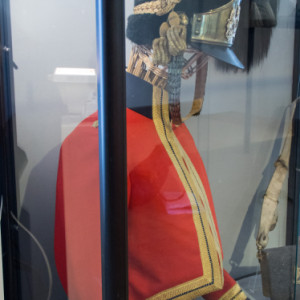17th June 1815
Yesterday was the 200th anniversary of the Battles of Quatre-Bras and Ligny.
Tomorrow is the 200th anniversary of the Battle of Waterloo.
My 3x great-grandfather Samuel Keeble was a trooper in the 2nd Royal North Regiment of Dragoons – colloquially called the Scots Greys because the entire regiment rode grey horses. For the first ten years of his service he had never been in battle or even left the British Isles, but in February 1815 Napoleon escaped from Elba, returned to France and resumed power, and thousands of British troops were ordered to the Continent - including the Greys, who formed part of the Union Brigade of heavy cavalry under the command of Sir William Ponsonby.
By early June only two of the Allied armies were in position to invade France – the Prussian army under Field Marshall Blücher, and Wellington’s Anglo-Allied army which was only about one third British, the remaining troops being primarily Dutch, Belgian and German. These two forces were massed on the northern border of France – Wellington’s to the west and Blücher’s to the east – and as together they significantly outnumbered his own army, Napoleon decided that they must not be allowed to unite. He therefore hatched a bold plan, which very nearly succeeded, to punch his way out between them into Belgium, fighting them separately rather than together.
On 16th June 1815 Napoleon launched his first surprise attack on the Prussians, who were routed at Ligny, and fell back to Wavre. At the same time he ordered Field Marshall Ney to attack Wellington - their engagement at the crossroads of Quatre-Bras was extremely bloody, but not decisive, but Wellington was prevented from going to Blücher’s aid and on hearing of the Prussian retreat he realised that he was in danger of being outflanked. Over the course of 17th June he withdrew his forces to the ridge of Mont St Jean, just south of the village of Waterloo, closely pursued by the bulk of the French army. The Union Brigade, which hadn’t been deployed during the Battle of Quatre-Bras, was used to protect the rear of the retreating army.
There was torrential rain through the day and night of 17th June, to the extent that many of the fields to either side of the cobbled highway were flooded, and the discomfort of the retreating men and their horses, all of them exhausted and many already wounded, is barely imaginable. Most of the troops of both armies spent the night of the 17th in the open, in filthy and drenched clothing, and owing to the difficulty of moving supply wagons over the sodden ground many were not even fed.
On 18th June the Scots Greys went down in military history for the most famous cavalry charge of the Battle of Waterloo. When the weak left wing of the Allied army began to crumble under repeated attack by French infantry columns, Henry Uxbridge ordered in the heavy cavalry including Ponsonby’s Union Brigade. They swept down through the French I Corps, scattering them and sabring anyone within reach, and buying precious respite for the Allies. Two French regimental standards were captured, one by the Royal Dragoons and one by the Greys. However, instead of then regrouping with the rest of the Brigade, the inexperienced Greys kept charging - into the bottom of the valley and up the opposite slope to the French artillery positions. They killed some of the gunners and disabled some guns - but when the French deployed their own heavy cavalry and lancers against them the Greys were in deep trouble, far from their own lines on blown horses, and they suffered appalling losses until the survivors were rescued by Allied light cavalry. The remnant of the Regiment rejoined the rest of the Union Brigade, but they took little further part in the battle.
The official Regimental history states that the Greys fielded 391 men at the start of the day, and by the end of it had lost 102 dead and 98 wounded. My own analysis of the muster rolls at the National Archives gives slightly different figures, but the proportion of dead and wounded to (relatively) unscathed is very similar. 164 of their horses also died.
I don’t know what part Samuel Keeble played in the battle, but I do know that at some point his horse fell and rolled on him, crushing his chest, and that he spent over a month in a hospital in Brussels before returning to duty. He was discharged from the Greys on 10th November 1819, suffering from rheumatism, deafness and a pulmonary complaint which were all attributed to his years of service. He worked as a groom for the rest of his life, and died in 1850 in Leeds – which by an odd coincidence is where this famous (and highly romanticised) painting of the charge of the Scots Greys by Lady Elizabeth Butler now hangs in the City Art Gallery.
Some of the men who fought at Waterloo wrote about it afterwards, or even gave lectures, but all I know about Samuel Keeble has been gleaned from documents in public archives. I find myself wondering if he bored his children (including my great-great grandmother, who was born three years after Waterloo) with stories of his exploits; or if he was one of those men who having taken part in battle never wants to speak about it afterwards – but obviously I will never know. The last footnote to Samuel’s story is that after his death his widow Betsy remarried; her second husband was a man called Thomas Wilemot, who had served in the same troop as Samuel at Waterloo, and who had employed Samuel during his later years. I find it interesting and rather touching that the friendship of these two men endured for so many decades.
The extra photo is an actual Scots Greys uniform, photographed in the museum at Waterloo.


Comments
Sign in or get an account to comment.


